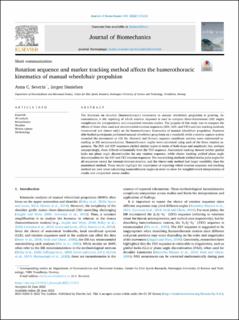| dc.contributor.author | Severin, Cecilia | |
| dc.contributor.author | Danielsen, Jørgen | |
| dc.date.accessioned | 2023-04-12T12:29:42Z | |
| dc.date.available | 2023-04-12T12:29:42Z | |
| dc.date.created | 2022-09-28T09:42:13Z | |
| dc.date.issued | 2022 | |
| dc.identifier.citation | Journal of Biomechanics. 2022, 141 . | en_US |
| dc.identifier.issn | 0021-9290 | |
| dc.identifier.uri | https://hdl.handle.net/11250/3062686 | |
| dc.description.abstract | The literature on shoulder (humerothoracic) kinematics in manual wheelchair propulsion is growing. Inconsistencies in the reporting of which rotation sequence is used to compute three-dimensional (3D) angles complicates the interpretation and comparison between studies. The purpose of this study was to compare the effects of three often used and recommended rotation sequences (ZXY, XZY, and YXY) and two tracking methods (anatomical and cluster only) on the humerothoracic kinematics of manual wheelchair propulsion. Fourteen able-bodied participants performed manual wheelchair propulsion on a treadmill, while a motion capture system recorded the movements at 120 Hz. Humeral and thoracic segment coordinate systems were constructed according to ISB recommendations. Humerothoracic angles were calculated using each of the three rotation sequences. The ZXY and XZY sequences yielded similar angles in terms of both shape and amplitude, but, perhaps unsurprisingly, these differed substantially from the YXY sequence. Anatomical tracking showed neither gimbal locks nor phase angle discontinuities for any rotation sequence, while cluster tracking yielded phase angle discontinuities for the ZXY and YXY rotation sequences. The two tracking methods yielded similar joint angles for all sequences except for internal/external rotation, and the cluster-only method had larger variability than the anatomical method. These results highlight the importance of reporting which rotation sequence and tracking method are used when calculating humerothoracic angles in order to allow for straightforward interpretation of results and comparison across studies. | en_US |
| dc.language.iso | eng | en_US |
| dc.publisher | Elsevier | en_US |
| dc.rights | Navngivelse 4.0 Internasjonal | * |
| dc.rights.uri | http://creativecommons.org/licenses/by/4.0/deed.no | * |
| dc.title | Rotation sequence and marker tracking method affects the humerothoracic kinematics of manual wheelchair propulsion | en_US |
| dc.title.alternative | Rotation sequence and marker tracking method affects the humerothoracic kinematics of manual wheelchair propulsion | en_US |
| dc.type | Peer reviewed | en_US |
| dc.type | Journal article | en_US |
| dc.description.version | publishedVersion | en_US |
| dc.source.pagenumber | 5 | en_US |
| dc.source.volume | 141 | en_US |
| dc.source.journal | Journal of Biomechanics | en_US |
| dc.identifier.doi | 10.1016/j.jbiomech.2022.111212 | |
| dc.identifier.cristin | 2056187 | |
| cristin.ispublished | true | |
| cristin.fulltext | original | |
| cristin.qualitycode | 2 | |

